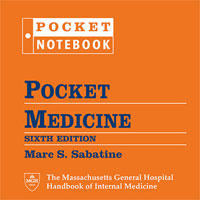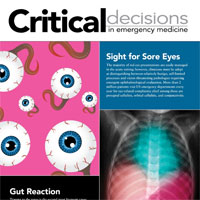Tag: diagnostics
Sepsis Test Could Show Results In Minutes
A new rapid test for earlier diagnosis of sepsis is being developed by University of Strathclyde researchers. The device, which has been tested in a laboratory, may be capable of producing results in two-and-a-half minutes,... read more
Antifungal Treatment in the ICU
Invasive fungal infections (IFIs) are a major cause of morbidity and mortality in critically ill patients. Almost 80% of IFIs are due to Candida spp., which are the third most common isolated microorganisms in the intensive... read more
Hoopla Aside, hs-cTnI is Not Catching Missed Mis
We have been searching for a tool to identify myocardial infarction patients who are truly safe for discharge ever since Pope, et al., found that we were discharging two percent of patients with MIs from the emergency department.... read more
Echocardiography and Lung Ultrasonography for the Assessment and Management of AHF
Echocardiography is increasingly recommended for the diagnosis and assessment of patients with severe cardiac disease, including acute heart failure (AHF). Echocardiography and LUS can assist in the rapid assessment of patients... read more
Clinical Performance of Beta-D-Glucan for the Diagnosis of Pneumocystis Pneumonia in Cancer Patients Tested with PCP PCR
Patients negative by both Beta-D glucan (BDG) and PCR were unlikely to have Pneumocystis pneumonia (PCP). In patients with a compatible clinical syndrome for PCP, higher BDG values (>200 pg/mL) were consistently associated... read more
Pocket Medicine: The Massachusetts General Hospital Handbook of Internal Medicine
Under the direction of Marc S. Sabatine, MD, MPH, Professor of Medicine, Harvard Medical School, Pocket Medicine provides the key information a clinician needs for the initial approach and management of the most common inpatient... read more

Hemodynamic Monitoring: Invasive and Noninvasive Clinical Application
Praised by nursing students for its straightforward language and readability, this interdisciplinary reference on bedside hemodynamic monitoring covers the technical aspects of clinical monitoring, including diagnostic and... read more

Value of variation index of inferior vena cava diameter in predicting fluid responsiveness in patients with circulatory shock receiving mechanical ventilation
The findings of this study suggest that the ΔIVCD performed moderately well in predicting fluid responsiveness in patients with circulatory shock receiving mechanical ventilation. Overall, 603 patients were included in this... read more
Diagnostic Accuracy of Chest Radiograph, and When Concomitantly Studied Lung Ultrasound, in Critically Ill Patients With Respiratory Symptoms
This meta-analysis demonstrates that chest radiograph has a low sensitivity and reasonable specificity compared with CT for detecting lung pathology in critically ill patients. The studies also investigating lung ultrasound,... read more
Common pitfalls in point-of-care ultrasound: a practical guide for emergency and critical care physicians
Point-of-care ultrasonography (POCUS) is a widely used tool in emergency and critical care settings, useful in the decision-making process as well as in interventional guidance. Following some rules in technique and interpretation,... read more
Antibiotic Decisions in the ICU: A Dragon’s Tale
Medical decision-making about antibiotic use in critically ill patients is challenging and complex. The need for antibiotic stewardship requires judicious prescription and choice of antimicrobials, as the need for effective... read more
Effects of Chlorhexidine Gluconate Oral Care on Hospital Mortality
Chlorhexidine oral care is widely used in critically and non-critically ill hospitalized patients to maintain oral health. We investigated the effect of chlorhexidine oral care on mortality in a general hospitalized population.... read more
Critical Decisions in Emergency Medicine
American College of Emergency Physicians regularly publishes Critical Decisions in Emergency Medicine to keep emergency medicine professionals up to date on relevant clinical issues. Build your clinical arsenal with Critical... read more

Reducing diagnostic errors in the ICU
Diagnostic error occurs in 5-20 percent of physician-patient encounters, with a comparable prevalence among ICU admissions and patients who die in the intensive care unit (ICU). Further, diagnostic errors comprise 9-12 percent... read more
Sophia Observation Withdrawal Symptoms-Pediatric Delirium Scale
The SOS-PD scale shows promising validity for early screening of Pediatric Delirium (PD). Further evidence should be obtained from an international multicentre study. A total of 2088 assessments were performed in 146 children... read more
How Mayo Clinic Is Combating Information Overload in Critical Care Units
Health care teams depend on electronic health records (EHRs) to compile important medical data from innumerable lab tests and medical devices, observations, treatments, and diagnostic codes. We rely on it so much that we... read more
Saving Lives in the ICU Through Artificial Intelligence
Hospitals today run according to evidence-based medicine. That makes for smart science. But for critical care, it can be a problem. A patient may appear normal, but if you had a sign that, in two to three hours, that patient... read more
Accuracy of Ultrasound Exam Performed by EM vs. Radiology Residents in the Diagnosis of Acute Appendicitis
Although the traditional approach to the diagnosis of acute appendicitis (AA) is using clinical methods, experience has shown that strict reliance on clinical data can lead to mismanagement or unnecessary surgery. US has... read more
Danger Signals in the ICU
Damage-associated molecular pattern activation and release is an important research for intensive care practitioners. It will add to our understanding of the phase and state of the innate immune response to an insult. Early... read more
Diagnostic Accuracy of Delirium Assessment Methods in Critical Care Patients
Delirium is a disorder of decreased ability to focus, sustain or shift attention, change in cognition and or perception. The main objective was to evaluate the diagnostic accuracy of Confusion Assessment Method for the ICU... read more
A Digital Revolution in Health Care is Speeding Up
Telemedicine, predictive diagnostics, wearable sensors and a host of new apps will transform how people manage their health. In the longer term, the biggest upheaval may come from the large technology firms. Amazon and Google... read more
Utility and Diagnostic Accuracy of Bedside Lung Ultrasonography During MET
Lung ultrasonography can be rapidly performed in the majority of patients with MET activation for respiratory deterioration. As an independent diagnostic test, lung ultrasonography is non-inferior to the medical emergency... read more









